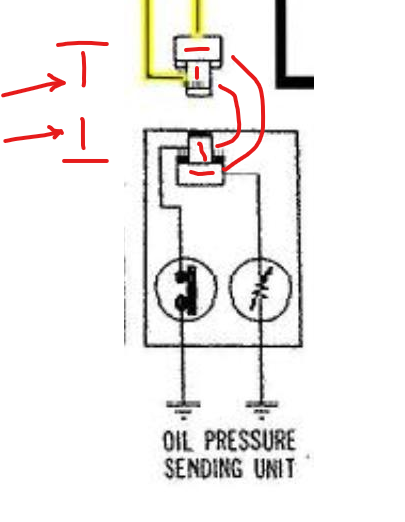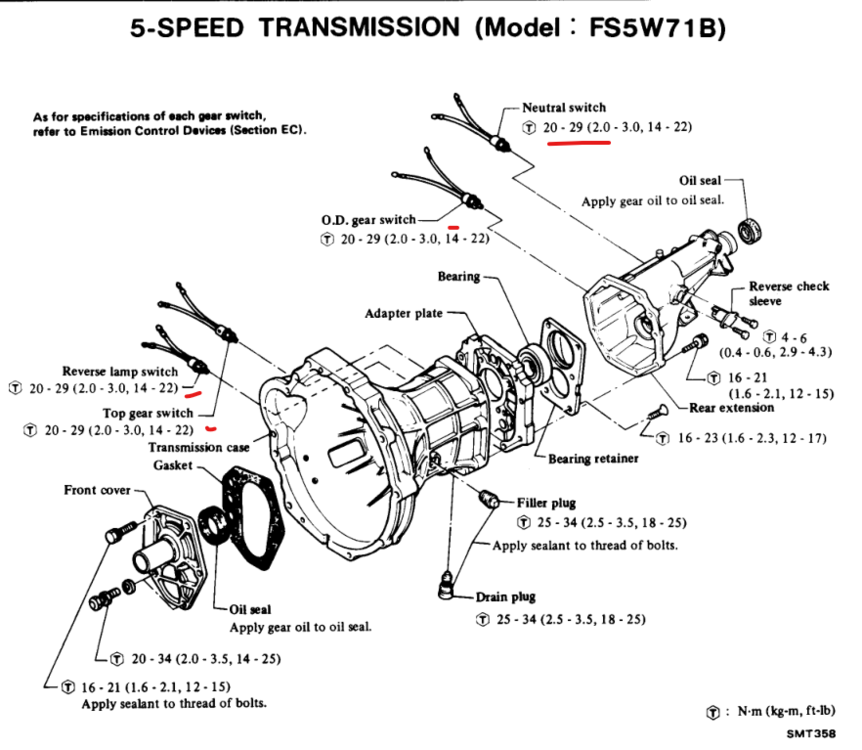Everything posted by Zed Head
-
'75 280Z - Starts and Runs, Shuts Off after 30-60 minutes
2nd edit, actually a post...just curious. I wonder if people could pop their caps and see if they have rubber on there. To CO's last post's point. Just one of those curiosities.
-
'75 280Z - Starts and Runs, Shuts Off after 30-60 minutes
Good catch. My Z didn't have one and never had a problem. The surfaces were both flat and sealed perfectly. It was actually a satisfying piece of plastics production. http://www.carpartsmanual.com/datsun/Z-1969-1978/engine-280z/cylinder-head
-
'75 280Z - Starts and Runs, Shuts Off after 30-60 minutes
No gasket, just plastic. It seals very well.
-
AFM/ Fuel Pump
Vertical would be the up and down part of the "T", the bottom. Horizontal would be the bar across the top. Follow the diagram, jump across the connection to the oil pressure portion.
-
Reaction Disk
Poke it, inside, with a screwdriver. If you feel metal it fell out. If it's rubbery it's still there. As long it's between the rod and the diaphragm seat when assembled it doesn't matter where it started. I don't know why they cal it a "reaction" disc. It should be called a damper or something similar.
-
AFM/ Fuel Pump
Hello @EuroDat I am pretty sure the switch opens when pressure is reached. A person could study the relay system diagram, and get a headache, or just work from the knowledge that if you remove the sender/switch plug (creating an open switch circuit) and turn the key on the pump will run. So you would want to wire up your 2nd relay to be open when power is applied through the key, then close when power is removed as the pressure switch opens. I think that leads to using 87a, normally closed when their is no power through the solenoid. It's a rare case of using the 87a circuit. Key on, the solenoid energizes, the 30 circuit is open, no power to the pump. Engine starts, oil pressure builds, the switch opens, the solenoid deenergizes, 87a is actuated, 30 gets power. I think this is right. The fact that you can pull the oil sender/switch plug and make the pump run is a well-known flaw in the design.
-
Is this L24 a lost cause?
Probably doesn't matter much. You have an L28 in your car because that's the easy way to get more power. The L24 will probably be worth something to somebody some day. The question is whether or not you want to be the keeper of the block. I'd give it away on Craigslist. Some Z head out there will probably take it and make something good from it. I sold my L28 engine for cheap after I replaced it with a better one. I knew I'd never do anything with it. Take the front cover and thermostat housing and other odds and ends that you can use on your L28 and give the rest away.
-
Is this L24 a lost cause?
Are you sure it's an L24? How does the crankshaft look?
-
1978 280Z Black Pearl with 18K Miles Sells for $57,500 on BaT
Weird. I did a little Googling and found what looked like an interesting "official" Nissan web site. But it has really bad information on it. Just flat wrong. https://www.nissanusa.com/experience-nissan/news-and-events/nissan-z-car.html THE NISSAN 280Z The next of the Datsun Z-Cars to launch was the 280Z in August 1978.
-
1978 280Z Black Pearl with 18K Miles Sells for $57,500 on BaT
My learning was that 77 was the 4 speed with a 5 speed option, and 78 was the opposite. There's probably sales literature out there somewhere. Release the Google...
-
Safety announcement: Check your steering mechanism’s safety, especially if a little sloppy.
You might swap your rear wheels for the fronts while you have things apart. See if the wobble follows the wheels. Of course, then you won't know if it's the TC rod upgrade or the wheels. Maybe take a for a test then swap if it's still there.
-
'75 280Z - Starts and Runs, Shuts Off after 30-60 minutes
Should have a thermotime switch, with an injector-type plug, and a coolant temperature sensor, also with an injector-type plug, and a temperature sender, with a single wire attachment. Later cars have a fourth switch, for the vacuum advance solenoid.
-
'75 280Z - Starts and Runs, Shuts Off after 30-60 minutes
Actually, heat soak has been a big problem with the 280Z's. We've had some good discussions about it in the past. Although, it's possible that the fuel blends have changed over the last few years and it's not as bad now.
-
1978 280Z Black Pearl with 18K Miles Sells for $57,500 on BaT
The COVID is giving people lots of free time to spend their money on the internet. That is a nice looking example of the $199 package. Odd that it came with a 4 speed though, I thought that the 5 speed was standard and the 4 speed was a requested change.
-
280z Cold Starts, dies when warm.
Have you checked the resistance at the ECU plug, on Pin 13? There are many possibilities, including a PO "tuning" around a problem instead of fixing it. Could be vacuum leaks. Could be something else. Another cause for popping back through the intake is a flat cam lobe. Hope that's not it. You really need to spend a little time at the ECU connector with the 1980 Guidebook and a meter. It has all years through 1980. Make sure everything is right before trying to fix things. Odds are though that the fuel tweak will still help after you get everything right. So that's not wasted time/money. You should check your fuel pressure with the engine not running also. If it can't get higher than 30 that's a problem. EFI work is just a long list of small things.
-
280z Cold Starts, dies when warm.
The fuel tweak was for the popping and stuttering, not the idling. Are you sure that you're disconnecting the sensor? There is also the cold start (thermotime) switch and the temperature sender in the same vicinity.
-
Help identifying 5-speed
Here's 82. The easy way to check is with a meter or continuity tester. The switches close when the condition is met. Top gear, reverse, etc.
-
'75 280Z - Starts and Runs, Shuts Off after 30-60 minutes
They're expensive and that might not be the problem. It's just a possibility. Some of us have found that any ECU from 75-78 will work on our cars. So if you find a cheap one at a wrecking yard it might be worth a shot. It could also be just a wire to your coolant temperature sensor. Or the sensor itself. If the connection gets open the ECU thinks you're in the Arctic. Working on these EFI systems is a process of understanding a collection of small systems and parts. Everything is old and could be failing. It's fun.
-
'75 280Z - Starts and Runs, Shuts Off after 30-60 minutes
Might be running rich. That's how the ECU's die. Run rich, kill engine. If you have a spare ECU it would be worth a quick swap.
-
'75 280Z - Starts and Runs, Shuts Off after 30-60 minutes
The stumbling and bumbling after letting it sit hot sounds like the heat soak problem. Your problem also sounds like a bad ECU. You should still watch your tachometer needle. It will tell you a lot if you look at it.
-
77 280z timing problem ***NEED HELP***
They're all very similar, changes were probably for emissions. If it doesn't have holes in it it's not a turbo cam. The turbos came out well after Nissan went to internal oiling. A cam with no holes in the lobes needs a spray bar. All of the L28's in the states are "E". Electronic fuel injection. Your main concern with installing a cam is to get good rocker arms on good cam lobes. You won't see much difference in performance between the variations but you can wipe out a cam lobe pretty easily.
-
'75 280Z - Starts and Runs, Shuts Off after 30-60 minutes
I knew I should have looked at that picture closer. Standard Nissan variable reluctor distributor. So, probably the original 1975 ignition module which was the second year of electronic ignition. And maybe a "performance"coil, putting more strain on very old electronics. The module is close to the fuse box, in the cabin. It will have aluminum fins and look very cool and space age. The symptoms sound just like when my 76 ignition module went bad. Rev it up to 3500 RPM, the tach needle starts reading double engine speed, and bouncing all over. Let it die and cool off and it's okay.
-
Rust Advice 78 280z
Yes, it clamps or compresses the injector in to the hole in the intake. The big rubber ring is where the force is applied to the injector body. It's a loosey-goosey mechanism, not precision.
-
'75 280Z - Starts and Runs, Shuts Off after 30-60 minutes
What is the Build Date? It's on the door jamb plate. I think that 75 only had one fusible link block, not two. Your car might be a 76.
-
Rust Advice 78 280z
Horrible! Drilling and tapping looks like the way to go. The shavings can be kept out of the intake easily, and the mount is not a super-precise fit. It's actually pretty loose, it's just a clamp for the injectors.









